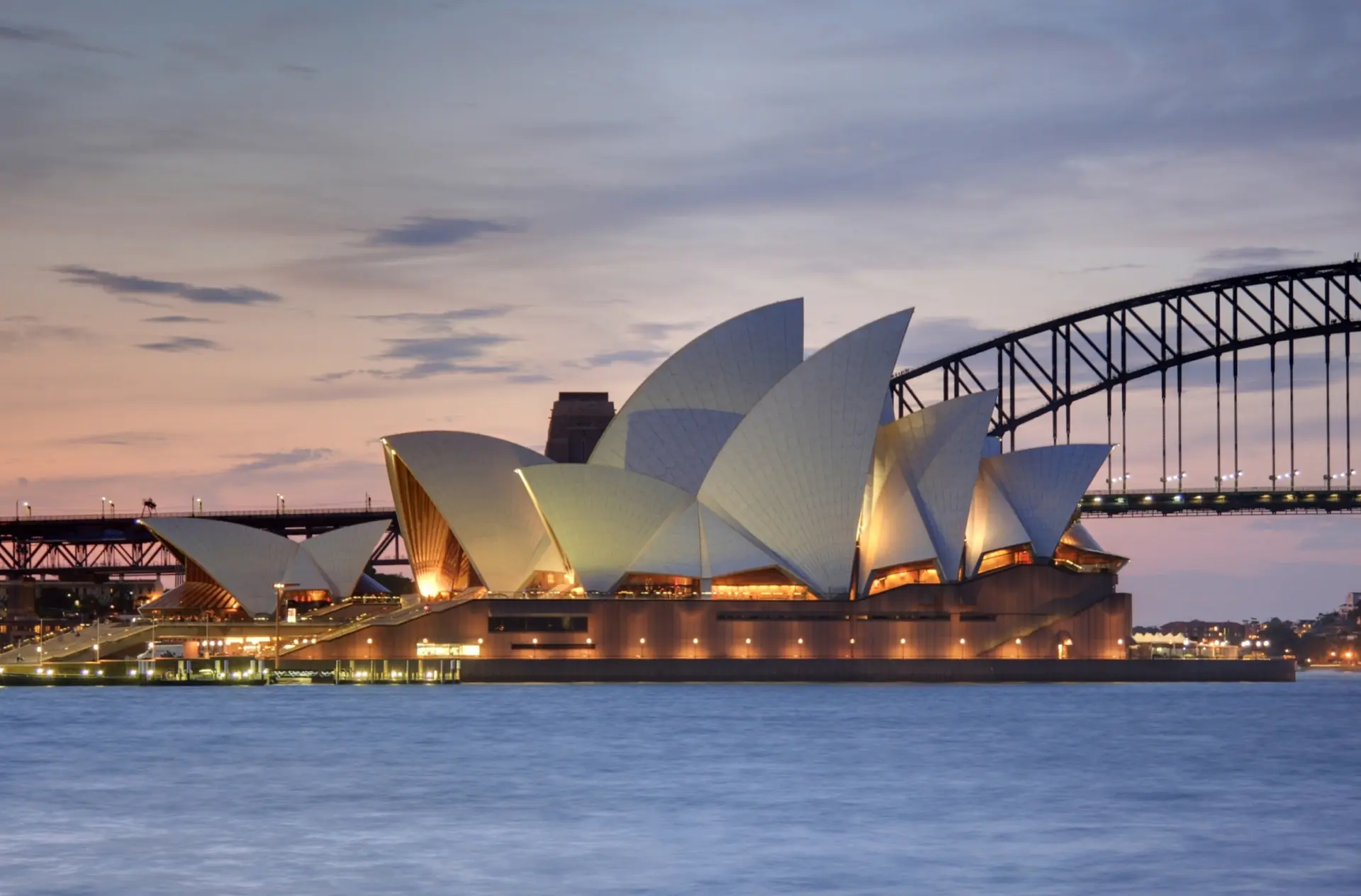
Sydney Opera House: Modernist Icon of Interlocking Shells
Utzon's Revolutionary Expressionist Masterpiece on Harbour
About This Site
The Sydney Opera House represents one of the 20th century's most audacious architectural achievements, transforming a bold competition-winning design into reality through groundbreaking engineering innovation. Jørn Utzon's visionary expressionist creation features three groups of precast concrete shells rising from a vast platform above Sydney Harbour, creating an instantly recognisable silhouette that has become Australia's most celebrated cultural landmark. This UNESCO World Heritage masterpiece demonstrates unprecedented technical innovation through its pioneering use of computer-aided design, spherical geometry solving complex structural challenges, and revolutionary construction methodologies that influenced generations of architects worldwide. The building's extraordinary aesthetic achievement harmonises sculptural architecture with harbour waterscape, establishing new possibilities for large-scale public architecture.
Why It Matters
This architectural masterpiece revolutionised modern architecture through unprecedented design innovation, establishing the Sydney Opera House as one of the indisputable masterpieces of human creativity. It demonstrates how visionary architecture can transform urban landscapes whilst inspiring global architectural practise through bold formal experimentation and sculptural expression.
Architectural Masterpiece Features
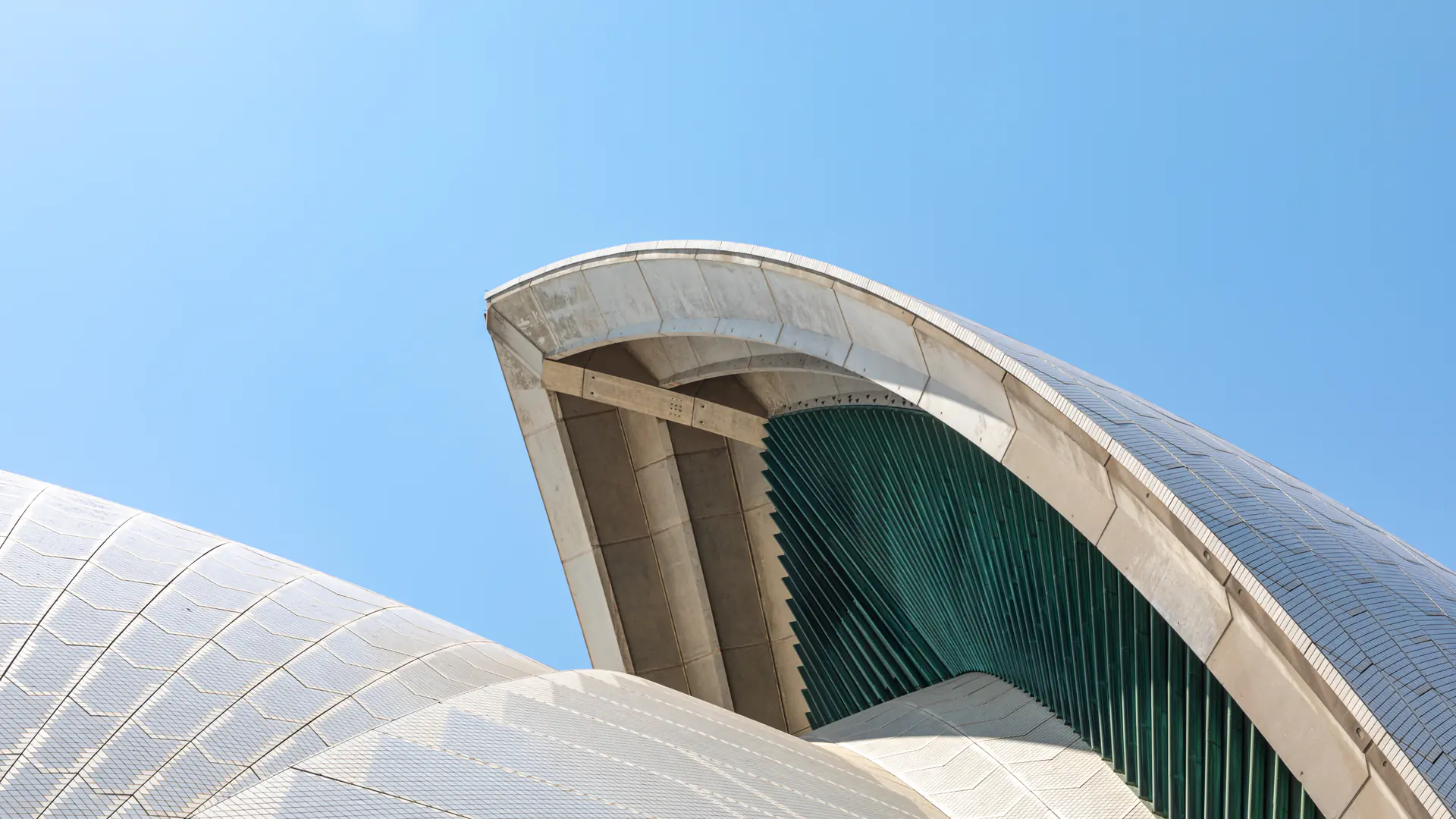
The Iconic Shell Structures
The building's most distinctive feature comprises three groups of interlocking vaulted shells creating an extraordinarily sculptural silhouette visible across Sydney Harbour. Each massive shell structure derives from a single spherical surface, an ingenious geometric solution enabling construction of the complex curves through 2,194 precast concrete sections weighing up to 15 tonnes each. This revolutionary structural approach required pioneering computer calculations and engineering innovation, establishing construction methodologies that influenced modern architecture worldwide. The shells' distinctive white ceramic tiles—1,056,006 individual Swedish-made tiles arranged in chevron patterns—create a gleaming surface that captures changing harbour light whilst establishing one of the world's most instantly recognisable architectural silhouettes.
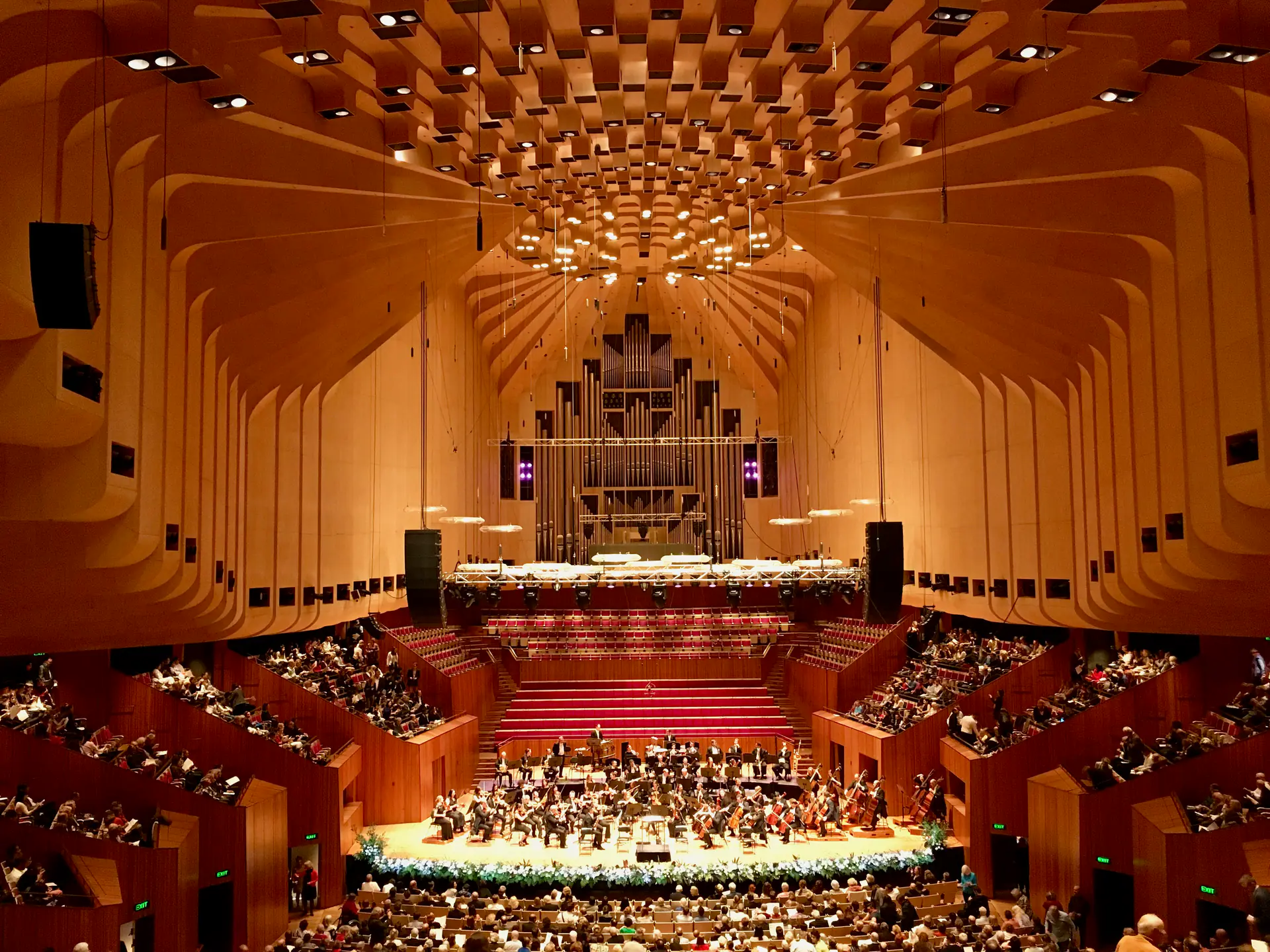
Concert Hall with Grand Organ
The Concert Hall represents Australia's premier performance venue, accommodating 2,679 patrons beneath the largest shell structure whilst showcasing the magnificent Grand Organ—one of the world's largest mechanical tracker-action organs with 10,244 pipes. Ronald Sharp designed this extraordinary instrument over a decade, creating a unique sound befitting the hall's exceptional acoustics and architectural grandeur. The hall's remarkable interior features birch plywood acoustic ceiling panels and distinctive white birch timber walls, creating warm visual aesthetics whilst optimising sound quality for orchestral performances. Extensive 2022 renovations enhanced acoustics through sophisticated reflectors whilst preserving Utzon's architectural vision, maintaining the hall's reputation amongst the world's finest concert venues for symphonic music, attracting renowned international orchestras and soloists.
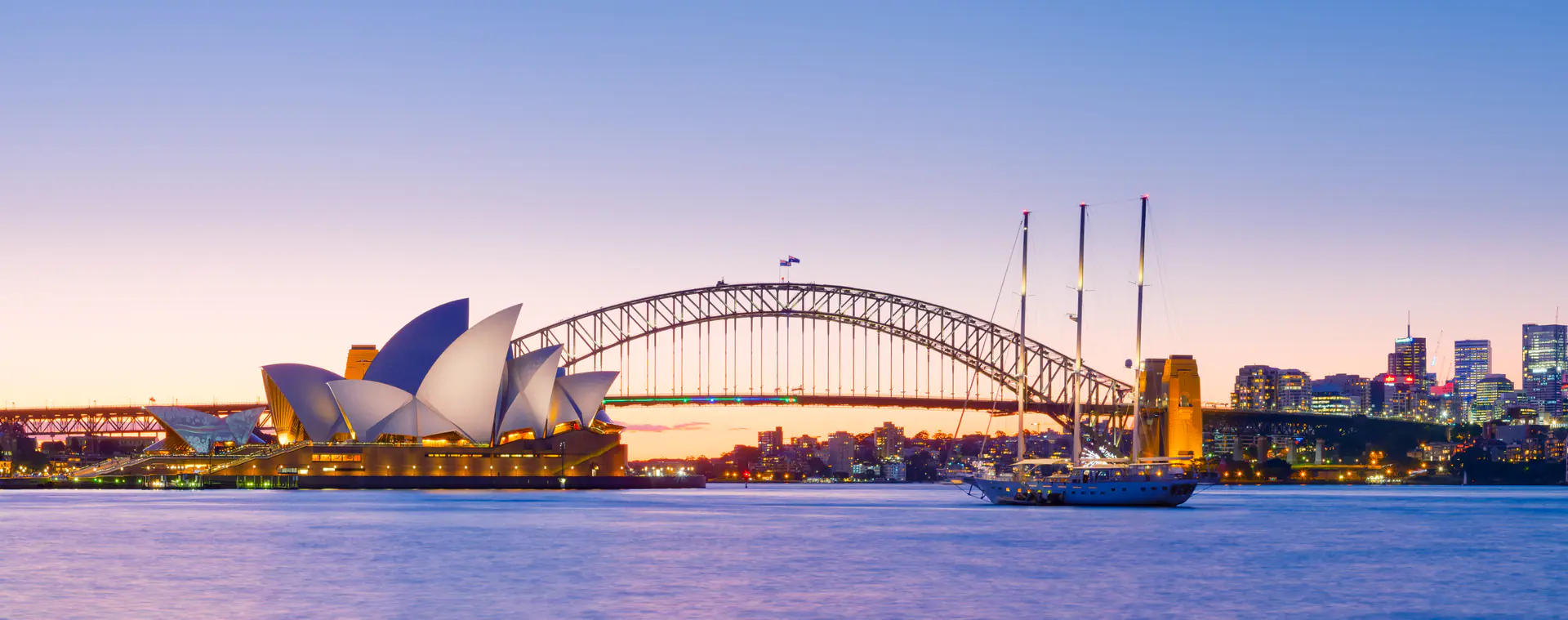
Harbour Setting at Sunset
The Opera House's extraordinary harbour setting at Bennelong Point creates one of the world's most spectacular urban waterfronts, where Utzon's architectural masterpiece harmonises perfectly with natural landscape. The building's dramatic peninsula location between Sydney Cove and Farm Cove provides breathtaking views across the harbour towards the Sydney Harbour Bridge whilst capturing changing light throughout the day. Sunset offers particularly magical experiences as golden light illuminates the white shell structures whilst the harbour transforms into shimmering bronze and purple hues. The expansive waterfront terraces function as pedestrian concourses connecting building to harbour, establishing public spaces that invite visitors to experience architecture within its extraordinary natural context whilst Opera Bar provides front-row seating for spectacular harbour sunsets.
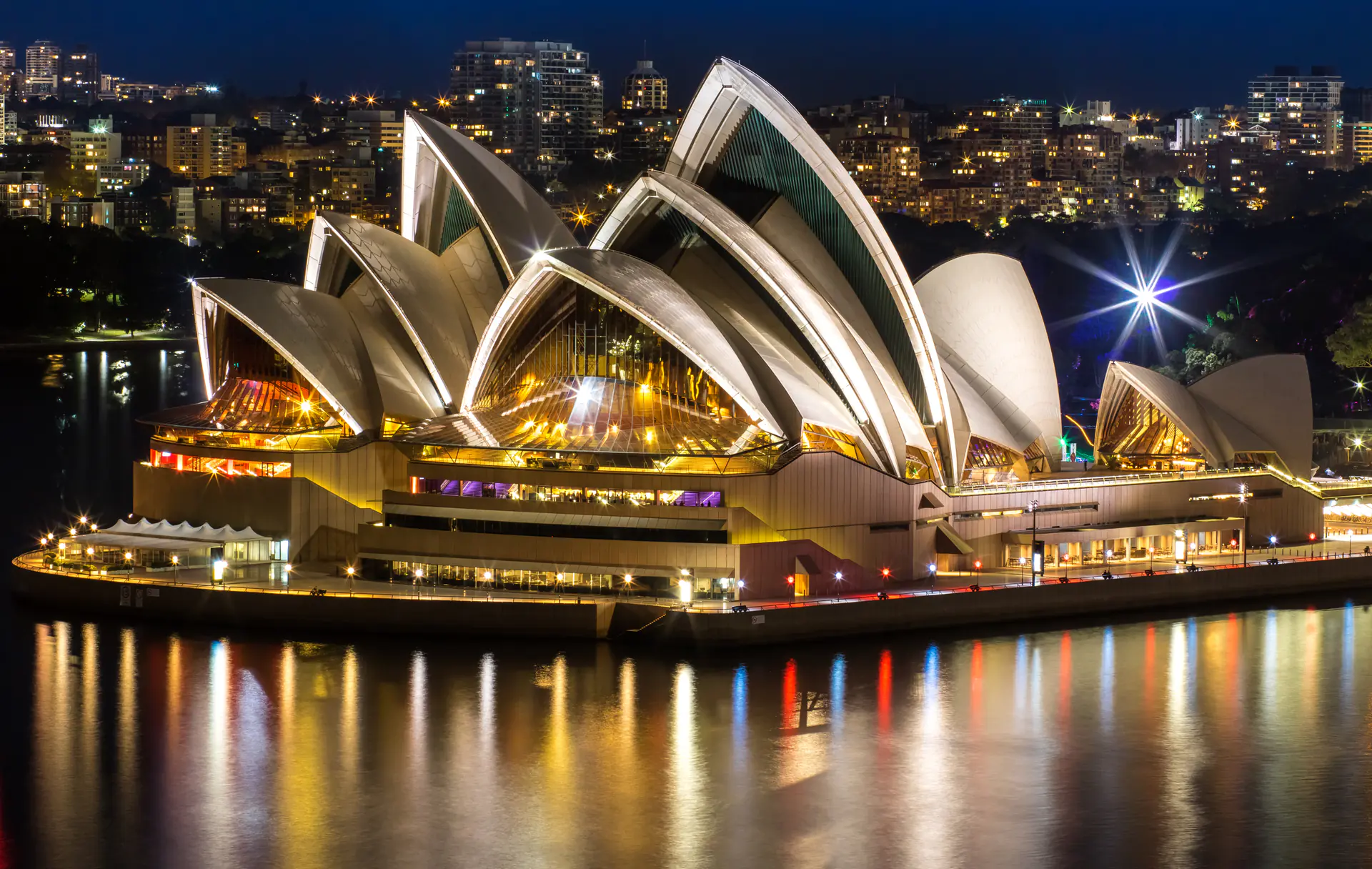
Illuminated Evening Architecture
The Opera House transforms after sunset into a luminous beacon across Sydney Harbour, with carefully designed lighting enhancing the building's sculptural forms whilst creating dramatic reflections in harbour waters. The sophisticated lighting design reveals the shells' architectural complexity through subtle illumination highlighting curves and surfaces that shift throughout evening hours. During Vivid Sydney festival each May-June, the building becomes a massive canvas for spectacular light projections and digital art installations, attracting millions of visitors who witness the shells transformed through kaleidoscopic colours and animated patterns. These extraordinary illuminations demonstrate how modern technology can enhance architectural heritage whilst creating new artistic experiences, establishing the Opera House as a dynamic cultural landmark that continues evolving whilst respecting Utzon's original vision.
Location & Planning
Located at Circular Quay, easily accessible via train, ferry, or 20-minute walk from city centre. Book guided tours and performance tickets weeks ahead through official website. Australian dollars (AUD) currency used throughout venue and surrounding precinct.
Loading map...
Frequently Asked Questions
The Sydney Opera House is a UNESCO World Heritage performing arts centre completed in 1973, famous for its revolutionary expressionist design featuring iconic white concrete shells. Architect Jørn Utzon created a modernist masterpiece that transformed architectural possibilities whilst becoming Australia's most recognisable cultural icon.
Danish architect Jørn Utzon designed the Sydney Opera House after winning an international competition in 1957. Construction began in March 1959 and completed in 1973, though Utzon resigned in 1966 during conflicts with government, with Australian architects led by Peter Hall completing the interior design.
Take a 20-minute walk from Circular Quay Station along the harbour foreshore, or catch the ferry to Circular Quay with stunning harbour views. Guided tours run every 30 minutes daily (except 25 December and selected days), requiring advance booking through the official website.
September through November offers pleasant spring weather with clear harbour views and outdoor events. Sunset provides spectacular photography opportunities from Opera Bar. The Vivid Sydney festival in May-June illuminates the building with stunning light projections, attracting millions of visitors annually.
Exterior areas and waterfront terraces are freely accessible year-round. Guided tours require advance tickets through the official website, whilst performance tickets must be booked separately through Sydney Opera House box office. Standard tours include 300 stairs; mobility-access tours available by arrangement.
Dress code varies by event: smart casual for guided tours, formal attire for gala performances, and relaxed clothing for outdoor concerts. Comfortable walking shoes recommended for tours. Layer clothing as harbour breezes can be cool even during warm days.
The building's revolutionary design solved unprecedented engineering challenges through pioneering computer-aided design and spherical geometry. Its iconic shell structures represent a radical architectural innovation that influenced modern architecture globally whilst creating an extraordinarily beautiful urban sculpture harmonising with Sydney Harbour waterscape.
The building features 2,194 precast concrete sections forming massive interlocking shells derived from a single sphere, enabling construction of the complex curves. This innovative solution required pioneering structural engineering and computer calculations, establishing new construction methodologies that transformed modern architecture worldwide.
UNESCO World Heritage Criteria
Inscribed in 2007, this site meets 1 of UNESCO's 10 criteria for Outstanding Universal Value
Criterion (i): Masterpiece of human creative genius
The Sydney Opera House represents an indisputable masterpiece through Jørn Utzon's revolutionary expressionist design combining unprecedented engineering innovation. The iconic interlocking concrete shell structures created an urban sculpture of extraordinary beauty whilst solving complex technical challenges through pioneering methodologies that transformed modern architectural practise worldwide.
Historical Context
Competition Victory (1957)
Danish architect Jørn Utzon won the international design competition with a visionary concept featuring distinctive shell structures, selected by jury member Eero Saarinen who recognised the design's revolutionary potential despite initial scepticism from other judges regarding construction feasibility.
Foundation and Podium (1959-1963)
Construction commenced March 1959 with foundation and podium work proceeding smoothly. Engineers built 588 concrete piers extending 25 metres below sea level through challenging harbour geology, creating the massive platform supporting shell structures whilst establishing waterfront terraces and concourses.
Shell Structure Engineering (1963-1967)
Engineers and architects solved unprecedented structural challenges through pioneering computer calculations, developing innovative spherical geometry enabling shell construction. The revolutionary solution involved deriving all shells from a single sphere, permitting manufacture of 2,194 precast concrete sections that interlocked to form the complex vaulted structures.
Utzon's Resignation (1966)
Political conflicts with New South Wales government regarding costs, design changes, and authority led to Utzon's dramatic resignation in February 1966. The architect left Australia never witnessing his masterpiece completed, though Australian architectural team led by Peter Hall continued interior design under challenging circumstances.
Completion and Opening (1967-1973)
Interior fit-out proceeded through 1967-1973 with Australian architects completing performance halls, installing the Grand Organ, and finalising technical systems. Queen Elizabeth II officially opened the building on 20 October 1973, fourteen years after construction commenced and significantly over original budget projections.
Recognition and Reconciliation (1999-2007)
Utzon reconciled with project in late 1990s, developing Design Principles guiding future changes whilst redesigning the Utzon Room. UNESCO inscribed the Opera House as World Heritage in 2007, recognising it as an indisputable masterpiece of human creativity that transformed modern architecture globally.
Decade of Renewal (2013-2023)
Nearly $300 million capital works programme modernised ageing technology, enhanced accessibility, and renovated performance spaces whilst respecting Utzon's architectural vision. The ambitious Concert Hall renovation completed July 2022, improving acoustics through sophisticated reflectors whilst preserving the hall's distinctive aesthetic character and architectural integrity.
Conservation & Protection
Current Conservation Status
Excellently preserved through ongoing conservation programmes protecting architectural integrity whilst adapting building for contemporary performance requirements and visitor safety standards.
Conservation Challenges
- Managing intensive daily use from 1,800 annual performances and millions of visitors placing continuous stress on historic fabric and infrastructure
- Weathering impacts on exterior tiles and concrete structures from harsh harbour salt spray and coastal environmental exposure
- Balancing strict heritage conservation requirements with modern performance technology and accessibility improvements
- Controlling moisture penetration and aggressive salt corrosion from proximity to Sydney Harbour marine environment
- Accommodating essential accessibility improvements and modern facilities within protected UNESCO architectural design constraints
Active Conservation Efforts
- Comprehensive Decade of Renewal capital works programme (2013-2023) investing nearly $300 million replacing ageing technology, enhancing accessibility, and renovating performance spaces
- Ongoing systematic tile maintenance and replacement preserving the building's distinctive white ceramic exterior using original Swedish manufacturing specifications
- Utzon Design Principles framework providing architectural guidelines for all building modifications ensuring compatibility with original vision
- Concert Hall acoustic enhancements completed 2022 improving performance quality through sophisticated reflectors whilst respecting Utzon's aesthetic integrity
- State, National, and World Heritage protection designation ensuring rigorous multi-level conservation oversight and approval processes
Image & Content Attribution
Research & Content Sources
Photography & Visual Media
Last updated: 11 October 2025